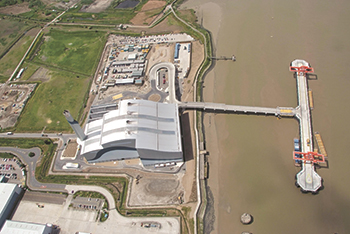Intercrete 4841 keeps chlorides in check
01 September 2019
Flexcrete Technologies’ Intercrete 4841 cementitious polymer coating has been certified to provide an effective barrier against chlorides that lasts more than 30 years.
Independent testing was carried out at the Vinci Construction Technology Centre in Bedfordshire, UK, to officially confirm the properties of Intercrete 4841 (formerly Flexcrete’s Cementitious Coating 851).
In 1988, a 2-mm-thick film of Intercrete 4841 was applied to a concrete slice and sealed in a chloride ion diffusion cell, and 30 years (10,950 days) later it is still providing full protection.
Continuous tests carried out in the Vinci Construction Technology Centre laboratory show that the barrier properties of Intercrete 4841 have remained the same throughout the test period, a testament to the product’s consistent and long-lasting performance, says a senior official of the company.
“The performance demonstrated in this test by Intercrete 4841 is unparalleled,” says Chris Lloyd, cofounder of Flexcrete Technologies, which was acquired by leading global paints and coatings company AkzoNobel in 2017.
He says: “In Vinci’s experience, many coating systems degrade over time when on test in the cell, and even products that initially perform well can subsequently blister, resulting in more chloride ions passing through the product.
“Intercrete 4841 has not shown any signs of deterioration despite being fully immersed in the chloride solution for 30 years. It would have taken 271 years for the product cell with the Intercrete 4841 to reach the same chloride concentration that the uncoated specimen reached in just 98 days.”
Intercrete 4841 is a two-component, waterborne cementitious polymer coating, originally introduced in 1985. It remains a market-leading solution to chloride attack and other forms of damage and corrosion by forming a hard, alkaline coating with outstanding pressure resistance.
Thanks to this advanced protection and proven performance, Intercrete 4841 is widely specified on both existing and new structures to waterproof concrete, reinstate concrete cover and provide an effective barrier against challenging conditions such as coastal environments, highways and water and wastewater industry.
It can also provide an alternative to the recasting or demolition of precast and in-situ reinforced concrete, reinforcing the substrate with the durability to achieve its specified design life, says the company.
- Peri serves an ace at university job
- ASTM test method aims to assess durability
- BMC Gulf to floor market with ‘concrete on a roll’
- Faro ensures precision in prefabrication
- Intercrete 4841 keeps chlorides in check
- Sharjah to shape first 3D printed home with CyBe



